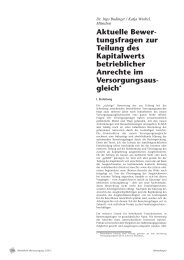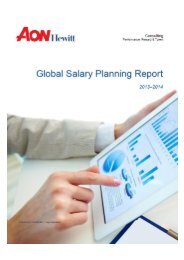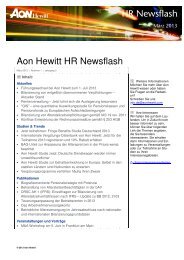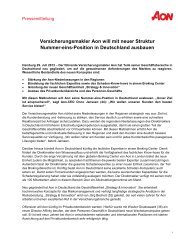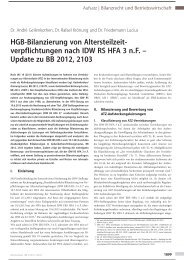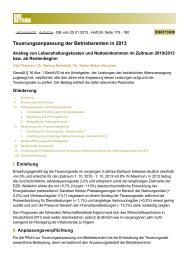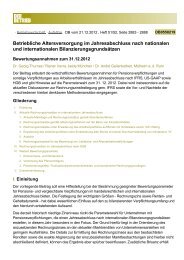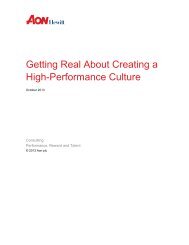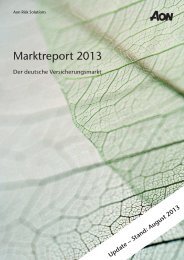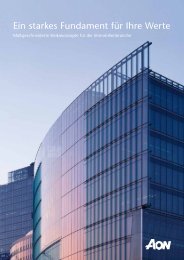Capital Allocation - Aon
Capital Allocation - Aon
Capital Allocation - Aon
Create successful ePaper yourself
Turn your PDF publications into a flip-book with our unique Google optimized e-Paper software.
Contacts<br />
ReMetrics—Financial Consulting<br />
<strong>Capital</strong> <strong>Allocation</strong> via a<br />
Rating Agency <strong>Capital</strong> Model<br />
August 12, 2008<br />
Patrick Matthews, CFA T: 215-255-4032 F: 215-255-4001 E: Patrick.Matthews@us.benfieldgroup.com<br />
Ankit Desai T: 215-255-4052 F: 215-255-4001 E: Ankit.Desai@us.benfieldgroup.com<br />
James Pogorzelski, CFA T: 215-255-4040 F: 215-255-4001 E: James.Pogorzelski@us.benfieldgroup.com<br />
Benfield Inc.<br />
3600 American Boulevard West<br />
Minneapolis, MN 55431<br />
www.benfieldgroup.com
Contents<br />
Introduction 3<br />
Why Is <strong>Capital</strong> <strong>Allocation</strong> Important? 4<br />
<strong>Capital</strong> <strong>Allocation</strong> via Best’s <strong>Capital</strong> Adequacy Ratio (BCAR) Model 5<br />
Overview of <strong>Allocation</strong> Algorithm 6<br />
Treatment of Growth Charge 8<br />
Treatment for Stress BCAR Implications 9<br />
Sample Output from Benfield’s OptiCap TM 11<br />
Pros and Cons of Using a Rating Agency <strong>Capital</strong> Model Approach 13<br />
Key Considerations 14<br />
About Benfield 15<br />
Disclaimer<br />
This paper is intended for general information purposes only and should not be construed as advice or opinions on any<br />
specific facts or circumstances. The analysis and comments in this paper represent general observations of Benfield and are<br />
based upon past experience with rating agencies. However, rating processes are forever changing; therefore, actual future<br />
rating actions may be materially different from the opinions expressed in this paper. The content of this paper is made<br />
available on an “as is” basis, without warranty of any kind. Benfield disclaims any legal liability to any person or organization<br />
for loss or damage caused by or resulting from any reliance placed on that content. Members of the Benfield ReMetrics –<br />
Financial Consulting Team will be pleased to consult on any specific situations and to provide further information regarding the<br />
matters discussed herein.<br />
A.M. Best is not affiliated with Benfield. A.M. Best was not asked to express any opinion or endorsement of Benfield’s<br />
OptiCap TM and they have not expressed an opinion or endorsement thereon.<br />
The information contained in this document is strictly proprietary and confidential, and intended only for the recipient<br />
Page 2 - ReMetrics—Financial Consulting - <strong>Capital</strong> <strong>Allocation</strong> via a Rating Agency <strong>Capital</strong> Model
Introduction<br />
<strong>Capital</strong> allocation has been the subject of many articles and abstracts discussing various approaches to allocating<br />
capital among lines of business or operating divisions. Many companies struggle with a basis of ascertaining how<br />
much capital is needed to support a specific line of business, operating division, etc. Consider some of the<br />
following general questions in order to help gauge the importance of capital allocation to individual circumstances:<br />
1) What lines of business (on a historical and prospective basis) have the most impact on capital needs to<br />
support the financial strength rating?<br />
2) Where can growth occur that will either be most efficient on a capital requirement basis or the most<br />
profitable on a risk-adjusted basis?<br />
3) Do traditional measures of performance, e.g., combined ratio, provide the best perspective to adequately<br />
measure profitability?<br />
These are only some of the fundamental questions that every insurance company wants to answer to operate<br />
successfully in a competitive environment. Offering practical methodology, this paper provides a basis for<br />
companies to answer important questions, like those noted above, and understand how business strategies will<br />
influence their financial rating.<br />
The scope of this paper discusses capital allocation for property & casualty (P&C) insurance companies from a<br />
Best’s <strong>Capital</strong> Adequacy Ratio (BCAR) model approach. A.M. Best is recognized as a leading insurance rating<br />
agency in the United States, assigning financial strength ratings to over 2,000 companies with surplus ranging<br />
from $1 million to more than $60 billion. A.M. Best’s rating criteria are based upon a quantitative and qualitative<br />
analysis of a company’s balance sheet strength, operating performance, and business profile. One of the key<br />
quantitative measures employed by A.M. Best is the BCAR, which is derived from a proprietary capital adequacy<br />
model that evaluates balance sheet strength. As such, BCAR is an important metric for all rated companies and<br />
thus has cost of capital implications. This concept and approach can also be applied to the capital models utilized<br />
by other rating agencies such as Standard & Poor’s (S&P), Moody’s, or Fitch Ratings.<br />
In conjunction with this paper, Benfield developed OptiCap TM , a proprietary capital allocation model designed to<br />
optimize capital by line of business within rating agency guidelines, which is largely based upon BCAR. The<br />
assumptions regarding the allocation algorithm are discussed within.<br />
The information contained in this document is strictly proprietary and confidential, and intended only for the recipient<br />
Page 3 - ReMetrics—Financial Consulting - <strong>Capital</strong> <strong>Allocation</strong> via a Rating Agency <strong>Capital</strong> Model
Why Is <strong>Capital</strong> <strong>Allocation</strong> Important?<br />
Given the lack of standardization and potential complexity underlying capital allocation, a practical question is<br />
“Why is capital allocation important?” By itself, capital allocation does not necessarily lead to better decision<br />
making. Further, there are industry professionals that disagree with the general concept of capital allocation, as<br />
all capital of the insurance entity is available to pay the claims of any line of business or policy. To counter that<br />
argument, capital allocation is not necessarily the end result, but more so a stepping stone in understanding and<br />
determining rates of return on a risk-adjusted basis. To that extent, many view the capital allocation process<br />
more closely to allocating the cost of capital. 1<br />
<strong>Capital</strong> allocation entails a process that leads management to examine results relative to exposure and identify<br />
areas of mismatch between return expectations and capital at risk. As a result, capital allocation can provide<br />
management with a framework to measure performance relative to the underlying risk of the business. Riskadjusted<br />
returns derived from capital allocation can be used as a basis for assessing:<br />
• Profitability—measure return on capital by line of business/division; may provide implied rate adequacy<br />
• Risk Measure—provide baseline of understanding risk by line of business/division; assess the impact of a<br />
change in the perception of risk (e.g., from a rating perspective)<br />
• Risk Mitigation—evaluate the effectiveness of risk mitigation strategies such as diversification, use of<br />
reinsurance and hedging strategies on capital requirements<br />
• Strategic Decisions—help determine the amount of business and product type to target or avoid<br />
• Compensation—incorporate for incentive compensation considerations relative to risk<br />
As enterprise risk management (ERM) has expanded and gained significant momentum in recent years, so has<br />
the consideration for economic capital models to assist companies with capital allocation needs. Similar to ERM,<br />
the rating agencies have been vocal about the benefits of capital allocation. A.M. Best has indicated that<br />
allocating capital by line of business can lead to “ultimately resulting in optimal capital utilization and maximizing<br />
risk-adjusted returns within each product line.” 2 Likewise, S&P stated that by allocating capital by line of<br />
business, “a company can develop programs that will support the optimization of risk-adjusted return” which is<br />
also a key element to achieve a “Strong” ERM rating. 3 Both rating agencies effectively indicate that they view<br />
capital allocation as an important step to optimize shareholder value. As such, the increased emphasis and<br />
importance of capital allocation within the industry is also connected to rating agency considerations.<br />
1<br />
Patrik, G., Bernegger, S., & Rüegg, M. B. (1999). The Use of Risk Adjusted <strong>Capital</strong> to Support Business Decision-Making.<br />
Casualty Actuarial Society Forum, Spring, Reinsurance Call Papers. www.casact.org/pubs/forum/99spforum/99spf243.pdf.<br />
2<br />
A.M. Best (2008) Best’s Rating Methodology: Risk Management and the Rating Process for Insurance Companies, Oldwick,<br />
NJ (25 January 2008). www.ambest.com/ratings/methodology/riskmanagement.pdf.<br />
3<br />
Standard & Poor's. (2005). Insurance Criteria: Evaluating the Enterprise Risk Management Practices of Insurance<br />
Companies, Standard & Poor's, McGraw Hill, USA.<br />
The information contained in this document is strictly proprietary and confidential, and intended only for the recipient<br />
Page 4 - ReMetrics—Financial Consulting - <strong>Capital</strong> <strong>Allocation</strong> via a Rating Agency <strong>Capital</strong> Model
The process of measuring and monitoring risk and return is a sound risk management practice. While some<br />
companies may not need a comprehensive economic capital model, understanding the amount of capital each<br />
line of business or division requires is still valuable information. Further, the perception of risk in the industry is<br />
not stagnant, so the process of allocating capital can help measure the impact of a change in risk on a company’s<br />
or line of business’s capital needs.<br />
In the end, the importance of capital allocation will vary by company and depend upon the level and complexity of<br />
risk. Likewise, if capital allocation is done in the backroom to simply generate a report that is not given much<br />
significance, then the benefits from capital allocation cannot be fully achieved. For capital allocation to provide<br />
value to the company, similar to ERM, it needs to be part of a framework that leads to decisions based upon its<br />
findings.<br />
<strong>Capital</strong> <strong>Allocation</strong> via Best’s <strong>Capital</strong> Adequacy Ratio (BCAR)<br />
Model<br />
A key element in any capital allocation process is understanding how capital is defined, as the definition may<br />
differ considerably. Some measures for capital include: statutory surplus, GAAP equity, rating agency capital,<br />
and economic capital, all of which can vary significantly for the same company. BCAR is a ratio from A.M. Best’s<br />
capital adequacy model that evaluates balance sheet strength by measuring adjusted surplus (numerator) relative<br />
to net required capital (denominator) to support risks emanating from invested assets, credit, reserves, premiums<br />
and business risk.<br />
Table I<br />
For purposes of the approach discussed<br />
herein, capital is considered under the context<br />
of rating agency capital as determined by<br />
BCAR (i.e., adjusted surplus). For more<br />
information on BCAR, see A.M. Best’s<br />
Methodology Paper, “Understanding BCAR”<br />
(ambest.com/ratings/methodology/bcar.pdf).<br />
For reference, Table I provides published<br />
BCAR minimums for B+ and higher ratings<br />
along with BCAR scores at the 25 th , 50 th<br />
(median), and 75 th percentiles by rating as of<br />
July 2008.<br />
Rating Published<br />
Minimum<br />
75 th<br />
Percentile<br />
50 th<br />
Percentile<br />
25 th<br />
Percentile<br />
A++ 175% 384% 305% 273%<br />
A+ 160% 368% 277% 207%<br />
A 145% 387% 276% 224%<br />
A- 130% 316% 239% 182%<br />
B++ 115% 287% 204% 165%<br />
B+ 100% 254% 176% 142%<br />
Source: A.M. Best’s “Understanding BCAR”; Best’s Statement File - P/C, US, v2008.7<br />
The following section provides an overview of the algorithm for using BCAR as a process for allocating capital,<br />
discusses the handling of specific BCAR variables (growth charge and stress test), and provides sample output<br />
from Benfield’s OptiCap.<br />
The information contained in this document is strictly proprietary and confidential, and intended only for the recipient<br />
Page 5 - ReMetrics—Financial Consulting - <strong>Capital</strong> <strong>Allocation</strong> via a Rating Agency <strong>Capital</strong> Model
Overview of <strong>Allocation</strong> Algorithm Exhibit I<br />
The approach for using BCAR as a capital allocation<br />
tool is to have capital allocated to each line of business<br />
up to an amount that results in the same BCAR score<br />
for all lines (i.e., BCAR Equivalency target). Since<br />
BCAR is a risk-adjusted measure, requiring each line of<br />
business to maintain the same BCAR score implies that<br />
each line of business has an equivalent amount of<br />
capital as measured on a risk-adjusted basis. The<br />
approach is based upon allocating reported surplus and<br />
not necessarily reconciling to the published BCAR<br />
score which is based upon all lines of business. This<br />
can also be performed by allocating more or less than<br />
100% of reported surplus if a company deems they<br />
have “excess” or a “deficit” in capital to support a<br />
specific rating level. Through this exercise, the<br />
resulting BCAR target will almost always be lower than<br />
the published BCAR score due to the unwinding of<br />
diversification and size benefits imbedded within the<br />
BCAR model when allocating capital by line of business.<br />
See Exhibit I for a simple illustration.<br />
Company <strong>Allocation</strong> By Line<br />
All Lines<br />
Adjusted Surplus $600 M<br />
Required <strong>Capital</strong> $300 M<br />
200% BCAR<br />
Comm. Auto<br />
Adjusted Surplus $180 M<br />
Required <strong>Capital</strong> $103 M<br />
175% BCAR<br />
Personal Auto<br />
Adjusted Surplus $120 M<br />
Required <strong>Capital</strong> $68 M<br />
175% BCAR<br />
Homeowners<br />
Adjusted Surplus $300 M<br />
Required <strong>Capital</strong> $171 M<br />
175% BCAR<br />
To determine Required <strong>Capital</strong> by line of business (LOB), Loss and LAE Reserves and Net Premiums Written<br />
(NPW) are analyzed first as they are already separated by Schedule P LOB. Next, Fixed Income and Equity<br />
Securities (i.e., Invested Assets) are allocated on the basis of the amount of Net Investment Income for a given<br />
LOB relative to the total Net Investment Income. For Interest Rate risk, the market values of bonds, preferred<br />
stocks, and mortgage loans are allocated in relation to the size of the Invested Assets. Amounts in the Business<br />
Risk section are allocated in relation to the Gross Premiums Written (GPW) by LOB. Credit risk has three<br />
components – Agents Balances, Reinsurance Recoverables, and All Other Receivables. Agents Balances by<br />
LOB is reported in Part III of the Insurance Expense Exhibit (IEE) while All Other Receivables are allocated in the<br />
same manner as the amounts in Business Risk. Reinsurance Recoverables are allocated using information<br />
contained within Schedule P and the IEE.<br />
Table II provides a summary of the allocation algorithm applied for the seven risk categories of required capital<br />
within BCAR: Fixed Income Securities, Equity Securities, Interest Rate, Credit, Loss and LAE Reserves, NPW,<br />
and Business Risk.<br />
The information contained in this document is strictly proprietary and confidential, and intended only for the recipient<br />
Page 6 - ReMetrics—Financial Consulting - <strong>Capital</strong> <strong>Allocation</strong> via a Rating Agency <strong>Capital</strong> Model
Table II<br />
REQUIRED CAPITAL ALLOCATION ALGORITHM<br />
Fixed Income Securities Assumes portfolio mix is the same for all LOBs. Invested assets are<br />
allocated based on the amount of Net Investment Income (including<br />
Realized <strong>Capital</strong> Gains) for each LOB, as reported in the IEE, relative<br />
to the total for all lines.<br />
Equity Securities Same approach as Fixed Income Securities<br />
Interest Rate Duration – assumed to be the same for all LOBs (although duration<br />
may differ significantly between short-tail and long-tail lines, the<br />
expected impact on BCAR is not material)<br />
Market Value – same approach as Fixed Income Securities<br />
Gross PML – determined by catastrophe modeled results<br />
Credit Agents Balances – per IEE – Part III<br />
Reinsurance Recoverables – percentage of ceded Case plus ceded<br />
IBNR (per Schedule P) plus ceded Unearned Premium Reserves<br />
(derived via the IEE) by line of business to total reinsurance<br />
recoverables as reported on Schedule F, Part III<br />
All Other Receivables – percentage of GPW by line of business<br />
Loss and LAE Reserves Reserves per Annual Statement’s Schedule P, Part 1 by LOB<br />
Net Premiums Written NPW per Page 8, of the Annual Statement, consolidated into Schedule<br />
P line of business<br />
Business Risk Percentage of GPW by line of business<br />
It is noteworthy to highlight that the underwriting risk components of BCAR, Loss and LAE Reserves, and NPW<br />
risks, typically account for two-thirds of gross required capital. As such, the results from this process are fairly<br />
robust because there is already by-line detail imbedded within the BCAR model output for Loss and LAE<br />
Reserves and NPW risks, which drive Required <strong>Capital</strong> within the model. Ultimately, assumptions for every<br />
category in all lines of business can be augmented, if additional information is available, e.g., fixed income<br />
duration by line of business.<br />
Reserve Equity is derived from required capital for Loss and LAE Reserves and Fixed Income Equity can be<br />
derived from Fixed Income and Interest Rate Risk required capital. As a result, these components of Adjusted<br />
Surplus are computed simultaneously with their related capital requirements.<br />
The information contained in this document is strictly proprietary and confidential, and intended only for the recipient<br />
Page 7 - ReMetrics—Financial Consulting - <strong>Capital</strong> <strong>Allocation</strong> via a Rating Agency <strong>Capital</strong> Model
UPR Equity is allocated using the IEE and Page 6 of the Annual Statement. Potential Losses (including<br />
catastrophes), i.e., Net PML, is determined through catastrophe modeling results and taking reinsurance<br />
structures into consideration. The final step is to determine Policyholder’s Surplus by LOB, which is an iterative<br />
process, as the goal is to find the highest BCAR score that satisfies all constraints, e.g., growth charge, stress<br />
BCAR thresholds (discussed within).<br />
Table III provides a summary of the allocation algorithm applied for the most common components of Adjusted<br />
Surplus within BCAR: Reported Surplus, UPR Equity (Net of Tax), Loss Reserve Equity (Net of Tax), Fixed<br />
Income Equity (Net of Tax), and Potential Losses (including catastrophes).<br />
Table III<br />
ADJUSTED SURPLUS ALLOCATION ALGORITHM<br />
Reported Surplus Calculated to result in the same BCAR score for all lines of business.<br />
The score itself may be several points below the entire company/group<br />
score to account for diversification and size benefits that a<br />
consolidated company would be afforded.<br />
UPR Equity NPW and Unearned Premium Reserves by LOB per Page 6 of the<br />
Annual Statement; Underwriting Expenses by LOB per the IEE, Part II<br />
Loss Reserve Equity Reserves per Annual Statement’s Schedule P, Part 1 by LOB<br />
Fixed Income Equity Difference between market value and statement value of fixed income<br />
securities as determined by Fixed Income Securities and Interest Rate<br />
risks noted in Table II<br />
Potential Losses Determined by catastrophe modeled results or actual losses from a<br />
catastrophe or non-catastrophe losses<br />
Other To be determined on a company-by-company basis<br />
Treatment of Growth Charge<br />
Growth charge is a penalty that A.M. Best assesses within BCAR on companies that have experienced significant<br />
growth from their perspective. A.M. Best believes that rapid growth comes with significant risk and may be a sign<br />
of weaker underwriting/pricing standards or lack of market knowledge leading to potential problems with claims<br />
handling and reserving practices. The basis for A.M. Best’s concern regarding rapid growth and thus the use of a<br />
growth charge stems from the findings in their insolvency/impairment studies that attribute rapid growth as a<br />
common cause related to impairments. 4<br />
4<br />
A.M Best. (2008). Special Report: P/C’s Low Impairment Trend Likely to Have Hit Bottom of Trough in 2007, Oldwick, NJ (19<br />
May 2008). www.ambest.com.<br />
The information contained in this document is strictly proprietary and confidential, and intended only for the recipient<br />
Page 8 - ReMetrics—Financial Consulting - <strong>Capital</strong> <strong>Allocation</strong> via a Rating Agency <strong>Capital</strong> Model
By default, the growth charge is calculated based upon the growth in GPW during the most recent year and is<br />
compared to the compound annual growth rate over a three-year period. Growth rate in excess of current<br />
thresholds set by A.M. Best (4% for one year, 6% based upon a three-year compound annual growth rate) results<br />
in a growth charge. Alternatively, A.M. Best analyzes growth based on exposure-based metrics such as policy<br />
count, which a company reports via A.M. Best’s Supplemental Rating Questionnaire (SRQ). Before a penalty is<br />
applied, the current thresholds allowed for policy count growth is 5% for a one-year period and 6% annualized<br />
over a three-year period. A.M. Best often prefers to use policy count data to determine whether a growth charge<br />
penalty needs to be applied, as it is generally viewed better than GPW for measuring exposure growth. The<br />
growth charge, which can be 0% at minimum and 50% at maximum, increases the required capital to support<br />
Loss and LAE Reserves and NPW risks.<br />
The challenge in assessing a growth charge within the <strong>Capital</strong> <strong>Allocation</strong> model lies in determining which of the<br />
following is a better approach:<br />
• Applying the overall company’s growth charge to all lines of business, or<br />
• Calculating a growth charge independently for each line of business<br />
Applying the overall company’s growth charge can penalize lines of business that do not warrant a growth charge,<br />
thereby increasing their implied capital requirements. Conversely, it might benefit lines of business that have<br />
experienced substantial growth (above the growth rate of the overall company), which suppresses capital<br />
requirements for those lines of business. However, the current measure of the growth charge is done on a<br />
portfolio basis and even though BCAR segments required capital by line of business for Loss and LAE Reserves<br />
and NPW, the same portfolio growth charge is applied to all lines of business.<br />
Calculating the growth charge independently for each line of business appears to be more appropriate within the<br />
context of a capital allocation framework. However, it should be noted that this method makes entering or<br />
expanding in a new line of business appear very capital intensive, even though it may be improving overall<br />
diversification. Further, under this method, growth in a complementary product may indicate a growth charge is<br />
applicable even though it is leveraging off a core product that is not experiencing significant growth. In these<br />
examples, applying a growth charge independently for each line of business may overstate capital requirements<br />
for some lines and understate it for others.<br />
In the end, our recommended approach is to review capital allocation results under both methods of determining<br />
the growth charge and employ judgment to determine which method is more appropriate for a given case.<br />
Treatment for Stress BCAR Implications<br />
In 2005, after consecutive hurricane seasons of significant frequency and severity, highlighted by Hurricane<br />
Katrina with over $44.9 billion in insured losses, 5 A.M. Best released its methodology of stress testing<br />
capitalization to withstand the impact from two catastrophic losses, i.e., Stress BCAR. In a Stress BCAR analysis,<br />
a company’s surplus in the Baseline BCAR model is reduced by the after-tax Net PML from a natural catastrophic<br />
event (larger of the 1:100 wind or 1:250 earthquake (EQ) or a recent actual event).<br />
5<br />
A.M Best. (2008). Special Report: Credit Crunch Clouds Outlook of Hurricane Insurers, Cat Funds, Oldwick, NJ (19 May<br />
2008). www.ambest.com.<br />
The information contained in this document is strictly proprietary and confidential, and intended only for the recipient<br />
Page 9 - ReMetrics—Financial Consulting - <strong>Capital</strong> <strong>Allocation</strong> via a Rating Agency <strong>Capital</strong> Model
Reinsurance recoverables are typically increased by 80% of the ceded losses, reinsurers are downgraded one<br />
rating level, and reserves are typically increased by 80% of the retained losses. Lastly, surplus is reduced again<br />
by the after-tax net PML of a second catastrophic event, the larger of a 1:100 wind (same as first event), or 1:100<br />
EQ, or 1:250 EQ (if different locale than first event EQ). The stated guideline is that Stress BCAR should not be<br />
more than two rating levels (i.e., 30 points) below the established minimum Baseline BCAR score required for a<br />
given rating.<br />
For more information on Stress BCAR, see A.M. Best’s Methodology Paper, “Catastrophe Analysis in Ratings”<br />
(ambest.com/ratings/methodology/catastrophe.pdf) and Benfield’s paper “Frequently Asked Questions regarding<br />
A.M. Best’s Analysis of Catastrophe Exposure”<br />
(www.benfieldremetrics.com/us/get.php?page=Rating_Agency_Consulting).<br />
It is noteworthy to mention that for companies that engage in predominantly catastrophe exposed business, the<br />
Stress BCAR score is often the key metric in determining capital needs and the overall rating—not the Baseline<br />
BCAR score. In these instances, the Stress BCAR score has to be at or above a target set by A.M. Best with the<br />
Baseline score and its difference relative to the Stress BCAR score are not as relevant. As a result, Stress BCAR<br />
can complicate the approach of allocating capital based upon an equivalent BCAR Target for all lines of business,<br />
i.e., each line is equally well-capitalized. As depicted in Exhibit II, capital was allocated among four segments<br />
achieving a Baseline BCAR Equivalency Target of 175%. However, when applying the Stress Test, Homeowners<br />
BCAR score drops by 60 points, which is much greater than the 30 point tolerance referenced above and noted<br />
by the red line on the graph.<br />
Exhibit II<br />
BCAR (%)<br />
220<br />
190<br />
160<br />
130<br />
100<br />
70<br />
40<br />
Amount of capital allocated to HO<br />
results in an equivalent BCAR<br />
score (175%), but fails the Stress<br />
BCAR test by falling more than<br />
30pts below Baseline BCAR target<br />
175 175 175 173 175<br />
170<br />
165<br />
115<br />
Personal Auto Homeowners Comm. Auto Property<br />
Baseline Stress<br />
Stress BCAR minimum –<br />
30pts below BCAR target<br />
As noted previously, A.M. Best allows the Stress BCAR to be up to 30 points lower than Required Baseline<br />
BCAR. Since the Stress BCAR for the Homeowners line drops by 60 points, this creates a situation where capital<br />
allocation needs to be adjusted to arrive at scores that would be more appropriate.<br />
The information contained in this document is strictly proprietary and confidential, and intended only for the recipient<br />
Page 10 - ReMetrics—Financial Consulting - <strong>Capital</strong> <strong>Allocation</strong> via a Rating Agency <strong>Capital</strong> Model
In general, the target Stress BCAR score should be at most 30 points below the by-line Baseline BCAR<br />
Equivalency target. In Exhibit II, this translates to a 145% Stress BCAR for the Homeowners line. Increasing the<br />
Homeowners Stress BCAR to 145% comes at the expense of lowered Baseline BCAR targets for other lines.<br />
Exhibit III shows the targets that would satisfy all constraints. Even though the Stress BCAR score for<br />
Homeowners is still 60 points lower after re-allocation, it remains within 30 points of the established BCAR<br />
Equivalency target (which is akin to the Required BCAR level referenced earlier).<br />
Exhibit III<br />
BCAR (%)<br />
220<br />
190<br />
160<br />
130<br />
100<br />
70<br />
40<br />
165<br />
155<br />
195<br />
135<br />
165 163 165<br />
160<br />
Personal Auto Homeowners Comm. Auto Property<br />
Revised Baseline Revised Stress<br />
A.M. Best may perform other stress test analyses as part of their overall rating analysis. These are not as<br />
standardized as the catastrophe Stress test and also not considered within Benfield’s approach. A method that<br />
requires each line of business to balance to the same Stress BCAR score was considered. This, however, was<br />
not appropriate, as equating Stress BCAR scores across lines of business (with only some subject to the<br />
catastrophe Stress test) may be overly punitive for property exposure. Further, given the same result, Benfield<br />
views that a Stress BCAR score indicates a stronger level of capitalization than the Baseline BCAR score.<br />
Sample Output from Benfield’s OptiCap<br />
Stress BCAR minimum –<br />
30pts below BCAR target<br />
See Exhibit IV for sample output showing the results of capital allocation by line of business for XYZ Insurance<br />
Co.<br />
The information contained in this document is strictly proprietary and confidential, and intended only for the recipient<br />
Page 11 - ReMetrics—Financial Consulting - <strong>Capital</strong> <strong>Allocation</strong> via a Rating Agency <strong>Capital</strong> Model
Exhibit IV<br />
200X BCAR Analysis - <strong>Capital</strong> <strong>Allocation</strong> By Line of Business<br />
(All numbers in $000s, unless noted otherwise)<br />
NET REQUIRED CAPITAL All Lines Homeowners Personal Auto Comm. Auto CMP Sum of LOBs<br />
Asset Risk<br />
Fixed Income 12,368 1,889 8,253 698 2,159 12,999<br />
Equity 40,373 6,165 26,939 2,278 7,046 42,428<br />
Interest Rate 13,051 1,736 8,708 588 2,019 13,051<br />
Credit<br />
Underwriting Risk<br />
49,550 1,755 13,470 33,195 3,949 52,370<br />
Loss Reserves 128,861 14,515 110,794 4,172 7,605 137,086<br />
Premium 288,225 59,114 153,821 18,207 100,152 331,294<br />
Business Risk 0 0 0 0 0 0<br />
Gross Required <strong>Capital</strong> 532,428 85,174 321,985 59,138 122,931 589,228<br />
Less: Covariance 201,906 23,719 126,054 26,821 22,013 198,607<br />
Net Required <strong>Capital</strong> (NRC) 330,522 61,455 195,931 32,317 100,918 390,621<br />
ADJUSTED SURPLUS<br />
Reported Surplus 635,645 116,949 297,886 47,367 173,443 635,645<br />
UPR Equity 40,910 6,035 20,342 5,518 8,004 39,899<br />
Reserve Equity 12,828 117 11,372 459 880 12,828<br />
Fixed Income Equity 0 0 0 0 0 0<br />
Less: 1st CAT Event Losses (43,550) (21,645) (6,175) 0 (15,730) (43,550)<br />
Adjusted Surplus (APHS) 645,833 101,456 323,425 53,344 166,597 644,822<br />
BCAR Score (APHS / NRC) 195% 165% 165% 165% 165% 165%<br />
Note: In the illustration above, all LOBs exceed the Stress BCAR thresholds and thus capital was not reallocated<br />
As the results in the illustration demonstrate, the BCAR scores for individual LOBs are lower than the combined<br />
“All Lines” BCAR that A.M. Best would generate. This is primarily due to the unwinding of diversification benefit,<br />
leading to a higher required capital for NPW and Loss Reserves Risks and ultimately, a higher Net Required<br />
<strong>Capital</strong> (NRC) amount than on a combined basis. The largest factors to determine NRC on a combined basis are<br />
NPW Risk and Loss Reserves Risk, while on an individual LOB basis it can vary, as can be seen in the<br />
Commercial Auto column. The new Allocated or Reported Surplus by LOB allows Benfield to further analyze<br />
each LOB to determine additional implications of <strong>Capital</strong> <strong>Allocation</strong>.<br />
As Exhibit V reveals, we can observe Premium Leverage and Profitability ratios on a by-line basis to ascertain<br />
which LOB contributes the most to profitability or subsidizes other lines by being less capital intensive. The<br />
results in Exhibit V correspond to the XYZ Insurance Company’s capital allocation results shown in Exhibit IV. It<br />
proves that while the company has a Premium Leverage ratio of 1.5x, it is only the Personal Auto (1.8x) segment<br />
that can write that amount. Homeowners and Commercial Auto lines are much more capital intensive and thus<br />
can write approximately 1.1x to 1.2x. Similarly, although the Return on PHS on a company-wide basis is an<br />
ample 19.1%, this is predominantly due to the Personal Auto line of business.<br />
Exhibit V<br />
All Lines Homeowners Personal Auto Comm. Auto CMP Sum of LOBs<br />
% of Net Reserves 100.0% 10.7% 81.5% 3.1% 4.8% 100.0%<br />
% of NPW 100.0% 13.4% 55.2% 5.9% 25.4% 100.0%<br />
% of PHS 100.0% 18.4% 46.9% 7.5% 27.3% 100.0%<br />
Implied NPW / PHS 1.5<br />
1.1<br />
1.8<br />
1.2<br />
1.4<br />
1.5<br />
Return on Allocated PHS 19.1% 1.5% 28.9% 3.0% 20.1% 19.5%<br />
The information contained in this document is strictly proprietary and confidential, and intended only for the recipient<br />
Page 12 - ReMetrics—Financial Consulting - <strong>Capital</strong> <strong>Allocation</strong> via a Rating Agency <strong>Capital</strong> Model
Pros and Cons of Using a Rating Agency <strong>Capital</strong> Model Approach<br />
In recent years, many companies significantly reduced property exposures as a result of the increased perception<br />
of catastrophe risk highlighted by record storm seasons in 2004 and 2005. Following these events, catastrophe<br />
modeled results significantly increased loss estimates and rating agencies applied higher capital requirements.<br />
Many insurers, despite a strong pricing environment, still required a reduction in their property book due to capital<br />
requirements. To some degree these decisions are a by-product of capital allocation, regardless of the risk metric<br />
or method utilized.<br />
There are numerous methods for capital allocation based upon a matrix of the appropriate risk measure and<br />
allocation method. As such, there is merit in utilizing rating agency capital models for the basis of a capital<br />
allocation approach, if only for comparison and informational purposes. Like any capital allocation approach,<br />
there are inherent advantages and disadvantages related to utilizing rating agency capital models.<br />
Pros<br />
Cons<br />
• The standardized nature of rating agency capital models means that there will be a high degree of<br />
consistency in the allocation algorithm and results interpretation from year-to-year. As nationally<br />
registered statistical rating organizations, rating agencies publish their methodologies and are required to<br />
solicit public feedback prior to making any changes. This makes their models more transparent and<br />
easier to understand.<br />
• For many companies the modeled results or return on capital are meaningful as capital requirements are<br />
heavily influenced by rating agencies (as many companies believe they are overcapitalized if not for<br />
rating agency requirements).<br />
• Other benefits include manageable data requirements (mostly reported financial results) and low resource<br />
commitment which further creates an underlying consistency between reported results and capital<br />
requirements. Most of the capital allocation models require a significant investment of time and resources<br />
to fine tune the assumptions to reflect a company’s risk profile. The resource constraints faced by many<br />
organizations deter them from adopting and properly implementing these models.<br />
• The models are mostly historically based, and as such may not adequately reflect a changing risk profile,<br />
nor do they consider all sources of risk. The capital factors vary by company but are not tailored to a<br />
company’s specific risk profile and often lag market conditions.<br />
• The model does not adequately recognize the duration of capital commitment, especially for long-tail<br />
business, or the increased complexity of insurance products. Although there is a higher degree of<br />
consistency in the algorithm year-to-year, thresholds can change (e.g., Stress Test) which can<br />
significantly alter capital requirements and allocation.<br />
• Rating agency capital models apply a simplistic formula approach to diversification and may not<br />
adequately capture hedging activities.<br />
The information contained in this document is strictly proprietary and confidential, and intended only for the recipient<br />
Page 13 - ReMetrics—Financial Consulting - <strong>Capital</strong> <strong>Allocation</strong> via a Rating Agency <strong>Capital</strong> Model
Many of these shortfalls are often similar to the reasons why rating agencies look beyond capital adequacy scores<br />
when making their final determination on a rating. Whether or not the disadvantages outweigh the benefits of<br />
using rating agency capital models for capital allocation purposes will invariably be determined on a company by<br />
company basis. Some key considerations will relate to the complexity of the company and its risks, the level of<br />
change within its risk profile, the importance of capital management, especially as it pertains to rating agency<br />
capital requirements, and the availability of resources.<br />
Key Considerations<br />
Throughout the industry capital allocation is a topic often discussed by senior management and consultants alike,<br />
but the process and results are far from standardized. When selecting and implementing a capital allocation<br />
model, senior management should incorporate some important considerations:<br />
• Company’s goals & objectives: The process often begins by establishing a risk measure as the basis for<br />
determining a capital allocation approach; however, there is no industry accepted optimal risk measure.<br />
There are also numerous methods that may be considered to allocate capital amongst various lines of<br />
business; therefore, the selected risk measure and approach should be closely aligned with the<br />
company’s goals.<br />
• Dynamic process: The process of allocating capital often contains as much “art” as it does “science” given<br />
numerous assumptions that are imbedded within the process that can significantly sway the results.<br />
Since management’s perception of these assumptions change, the model has to be revisited continually<br />
over time.<br />
• Data Quality: Just like any other system in place, the findings are only as good as the quality of the<br />
underlying data and assumptions therein.<br />
• Regulatory Issues: There is the potential for regulatory constraints as it applies to the practical aspects of<br />
re-allocating capital among members of a group.<br />
Given the considerations above, it is unlikely that one capital allocation model fits the needs of all organizations.<br />
For companies burdened by resource constraints, our suggested model may be a more pragmatic approach to<br />
this capital allocation riddle.<br />
The information contained in this document is strictly proprietary and confidential, and intended only for the recipient<br />
Page 14 - ReMetrics—Financial Consulting - <strong>Capital</strong> <strong>Allocation</strong> via a Rating Agency <strong>Capital</strong> Model
About Benfield<br />
Benfield is the world’s leading independent reinsurance and risk intermediary. With more than 1,900 employees<br />
in 50 offices around the world, we have the reach and the resources to deliver traditional reinsurance or capital<br />
market solutions, for any client, anywhere. Our clients include many of the world’s major insurance and<br />
reinsurance companies as well as government entities and global corporations.<br />
The Benfield ReMetrics Financial Consulting team specializes in providing financial and strategic analysis on<br />
issues that influence a company’s financial strength rating such as “stress” testing, growth plans and/or change in<br />
reinsurance structures. Other consulting services provided include enterprise risk management, capital<br />
management, and reinsurance impact analysis. For more information, please visit our website<br />
www.benfieldremetrics.com.<br />
Benfield’s OptiCap TM model determines how much capital is required to support a client’s specific line of business<br />
from A.M. Best’s BCAR perspective. Results can be used to measure or gauge profitability, align compensation<br />
strategies relative to corporate risk appetite, diversification, and mitigation strategies such as use of reinsurance,<br />
and other hedging activities. Other benefits include consistent and transparent allocation algorithm, meaningful<br />
results, and low resource commitment.<br />
The information contained in this document is strictly proprietary and confidential, and intended only for the recipient<br />
Page 15 - ReMetrics—Financial Consulting - <strong>Capital</strong> <strong>Allocation</strong> via a Rating Agency <strong>Capital</strong> Model



